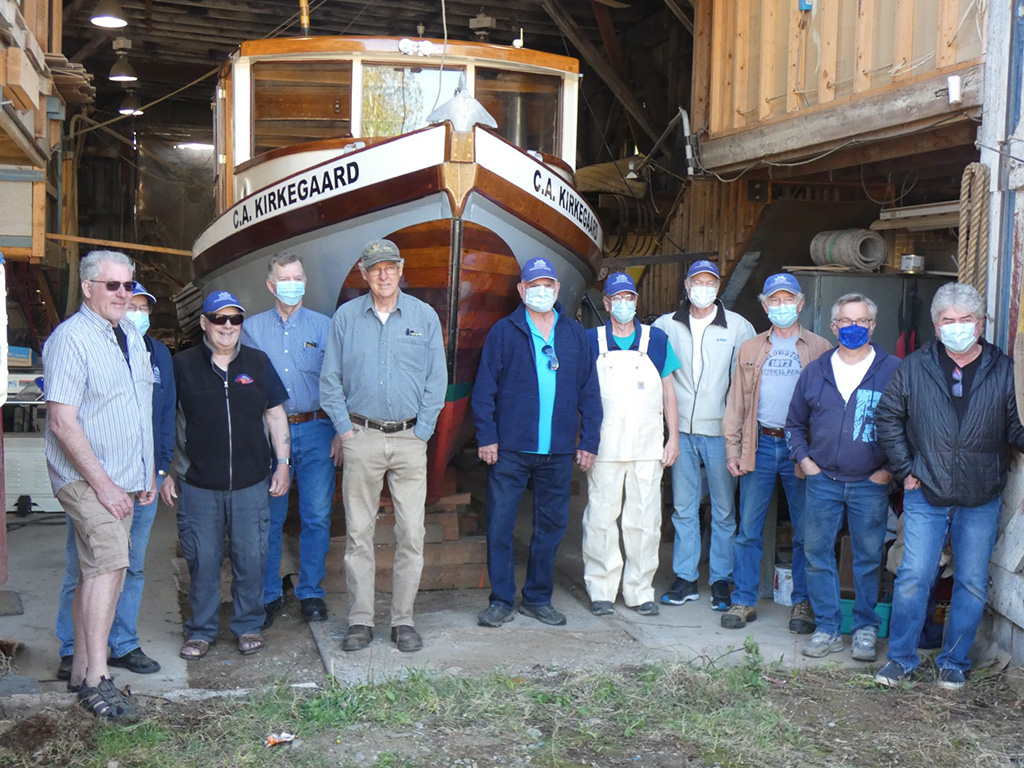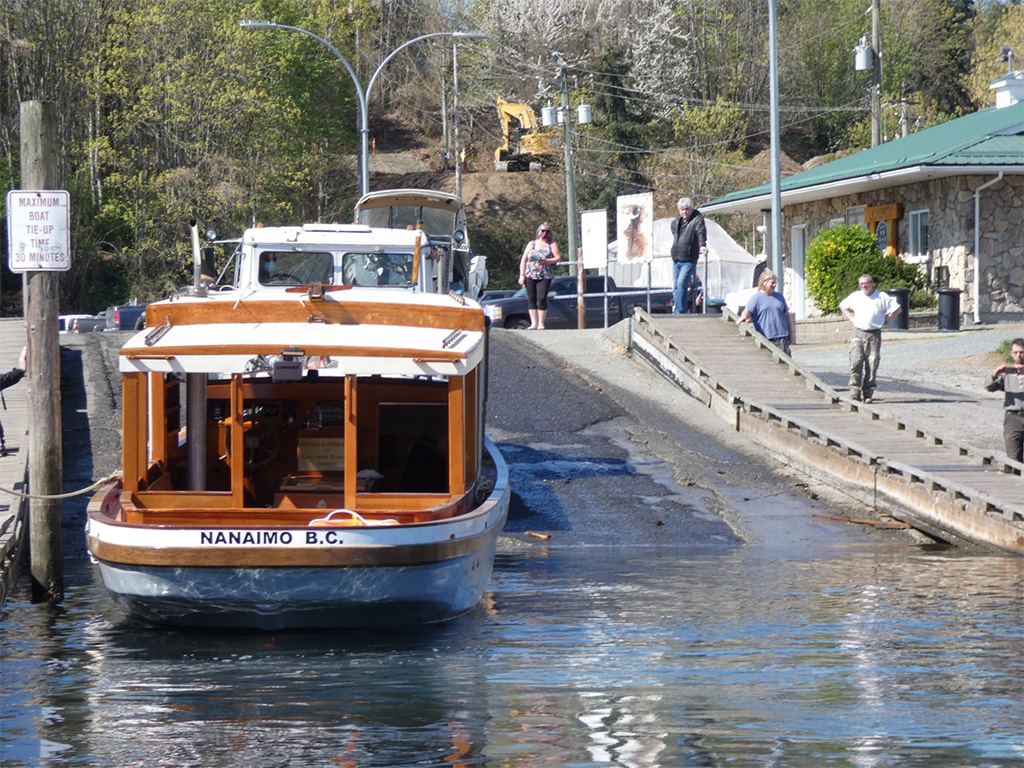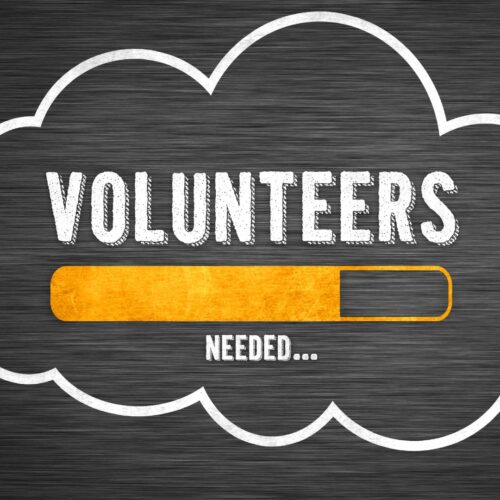Archive
LMS Purple Martin nesting colony update and success of the recovery effort
Another summer nesting season has passed and the Purple Martins that spend spring and summer at LMS Marina have nested, raised young and long departed on their southern migration, so it’s time for an update. The questions we’re most often asked while working with the martins and nest boxes on the docks are: “What are these delightful cheery birds, why are they nesting here, and what are you doing with them?“, as well as “Where do they go for the winter?“ by newer LMS members and visitors not yet familiar with this aspect of the marina, and of course “How are they doing this year?“ by the longer term members and regular visitors, who have already heard the answers to the previous questions and maybe even read the recovery program information and brochure! Here are the answers.
They are a designated species-at-risk throughout their breeding range, primarily because of extensive long term population declines due to nesting habitat loss, mainly to over a century of timber harvesting, fire suppression and agricultural and urban development on the coastal lowlands. Historically they were a fire-dependant species for periodic creation and renewal of their original snag stand nesting habitat (a transitional habitat type with no economic value for timber production, so when it occurs it is salvage harvested and replaced by a new crop of tree seedlings for the next harvest rotation).
In BC they had declined to less than 10 known pairs on SE. Vancouver Island by the early 1980s. They were “Red-listed” (Threatened – continued presence in the province uncertain) for many years prior to 2006, and “Blue-listed” since as a species of Special Concern (stable or increasing slowly, nesting in human-supplied and maintained nest boxes on coastal marine pilings, but still Vulnerable to being lost from the province with further population declines). They have no identified or protected wild cavity-nesting habitat remaining in BC and there is no strategy to create suitable new natural snag stand habitat, which means they will continue to be dependent on supplied artificial housing for the foreseeable future.
Why are they nesting at LMS and some other marinas and coastal piling sites? They have nested almost entirely in nest boxes on coastal marine pilings in BC since the start of the nest box-based recovery program almost 40 years ago, when there were less than 10 pairs remaining in BC (a similar nest box program was started in Puget Sound, WA, a decade earlier for the southern portion of this Salish Sea population). Previously they had adapted to nesting in woodpecker cavities in abundant untreated and slowly decaying wooden marine pilings in BC, WA and OR for a century or so prior to WW II. They became trapped there as refuge habitat in the mid-1900s by progressive loss of their original upland snag stand nesting sites on the adjacent coastal lowlands, then were forced into prolonged decline by gradual loss of nest sites as these old decaying and cavity-riddled pilings fell or were replaced with creosote-treated pilings, which provide negligible nesting opportunities for woodpeckers or Purple Martins. Martins were still nesting in old piling cavities at the LMS Marina site in the late 1980s when the first nest boxes were added, and likely much earlier – it’s one of the oldest surviving piling nest sites and one of the original 3-4 nest box colony sites, now the largest colony on Vancouver Island and one of the largest in BC with 100 nest boxes, housing over 6% of the BC population. In 2014 LMS was awarded a provincial Certificate of Recognition by the BC Ministry of Forests, Lands and Natural Resource Operations for their significant role and many years of excellent work hosting and contributing to the stewardship and recovery of this at-risk species, which is displayed with other awards in the Welcome Centre.
“Where do they go in fall and winter?” Martins nest much later than the other smaller swallows, waiting until the conditions and food supply improve for raising their single brood per season, typically from late May or June until mid-late August with a wide range of individual nesting timing, so young fledge from late July until the end of August. In late summer, after the young have fledged, adult birds with earlier nesting timing begin to leave in early August and most are gone by mid August (a few may remain longer), with newly fledged juveniles leaving on their own a little later. They head directly (over 3-4 days) to post-breeding roosts in the warm food-rich deserts of southwest USA (Arizona) and northern Mexico to complete their fall moult in September-October. They also add fat as fuel for their annual migration to southern Brazil in October and November for a second warm sunny austral spring and summer with an abundant flying insect food supply, while we wait out the fall and winter rainy season.
So much for the recovery program background for the relative newcomers… What most longer term members really want to know is “How did the martins do this year?“
The good news is that with the exceptional almost continually sunny, warm and dry weather since the end of April (rather than our usual prolonged cool wet spring extending into June and even July, as in the previous several years), the martins have had as very good year. Much like many of us (but for different reasons), martins are primarily creatures of sunshine and warm weather. As aerial insectivores they cannot forage successfully for flying insects in cool (<10°C) or wet weather when their prey is not on the wing, and in SW BC they are at the northern edge of their climate-limited breeding range, so they do well in warm dry years with abundant food supplies and struggle to survive, produce eggs and successfully raise young in cool wet years when food supplies may be scarce for the first half of the nesting season. This is not apparent to the casual observer – the martins are still active and vocal around the colony and appear to be doing well, but cool wet spring and early summer weather takes its toll in increased mortality and reduced nesting success and production.
As well, this year the nest box with the martin-cam beside the Adair Boat Shed with restored heritage vessels was occupied for the first time in several years and the pair successfully raised 4 young, and (after I repaired corroded camera connections and replaced the finally defunct used monitor I donated years ago) those interested were able to follow their progress both on-line via the Purple Martin page of the LMS website and on the dock at the new monitor on the Adair Boat Shed.
This pattern of success is consistent for the other index colonies we monitor in central Vancouver Is. and several other regions as well, indicating a very successful nesting season overall, with a probable further increase in population next summer. Based on our monitoring observations, the current Western Purple Martin population in SW. BC is estimated at ~1,500 pairs in nest boxes and piling cavities at over 150 colony sites extending as far east as Mission and Squamish, and as far north as Tofino on the outer west coast and Malcolm Island and Port McNeill in Johnstone Strait, some of which consist of only one to several cavities in old abandoned coastal marine pilings, often in remote areas. This is a huge improvement from where we started with a few last piling cavity sites in SE Vancouver Island, but still a very small breeding bird population for this corner of the province, and since it’s almost entirely dependent on human-supplied and maintained artificial housing for nesting opportunities, is still vulnerable to population declines with neglect.
There is sometimes another question from the longer term members and friends, along the lines of the rhetorical “Are you folks still doing this!?” (the answer is obviously “Yes”), or the more inquisitive (and sometimes almost incredulous) “How long have you been doing this!?”… Over 25 years, depending on when you start counting as we became increasingly involved in the volunteer recovery project and it grew to occupy more of our time – there is nobody else available with the interest, skills, permits and biology experience and credentials to take on the local maintenance and overall program management tasks involved at the moment. Hopefully in a COVID-stabilized world we can get our volunteer program back on track.
However, there is one question we’re unfortunately rarely asked: “How can we help to support the recovery program?” Since we’re an underfunded and entirely volunteer-supported non-profit organization, there are many ways… Assistance with cleaning and maintaining nest boxes in fall or spring (in favourable weather on suitable high tides) is always welcome – we will provide a brief training session for those interested – contact us at pmartins@island.net. Offers to build unique standard design western martin nest boxes, as per the directions available from our website (our martins have very specific nest box requirements for successful nesting and the current design has been developed over many years ) are also welcome and gratefully received – in some cases we can even provide materials or reimburse materials costs. We always have far more aging nest boxes coming due for replacement (and often beyond further repair) than we have available on hand.
Refundable water, pop, beer and alcohol beverage containers can be donated to support the recovery program (it helps to cover our fuel costs) at the bins marked for this purpose (NO non-refundable plastic, glass or metal containers, cardboard or other general recycling waste please) located at the restaurant and social dock and on the dock between “B” and “C” docks beside the museum (the old recycling area), but please NOT in the recycling bins outside the main gate beside the parking lot, which are intended for non-refundable recycling waste (metal, glass, plastic and cardboard) and emptied into the recycling truck for disposal.
As well, donations to support the recovery program can be made on-line via our Western Purple Martin Foundation website (www.saveourmartins.org) and are much appreciated – for donations of $20 or more a tax receipt will be provided. In addition to the time involved, there are significant fixed costs (fuel, materials and supplies, etc.) to conduct the monitoring and maintenance work, and most of our volunteers and private and corporate sponsors disappeared during the COVID shutdown and haven’t returned or been replaced, so every donation helps (100% of all donations directly support the recovery program). Thank you!
Here’s hoping the martins returning to LMS Marina still have a home to come back to in spring and we can enjoy the activities and cheerful song for another season, and hopefully many more to come.
Cheers, …Bruce
Volunteer Opportunities – Be Part of our Best Summer Ever!
How about this for a volunteer opportunity?
We need deckhands for the C.A. Kirkagaard. When this lovely restored vessel – which is a piece of BC coastal history – sets out on a tour, a person in addition to the primary operator is needed. Volunteer deckhands must be agile, personable and have some boating experience. A PCOC would be an asset. Volunteers will be given training in simple rope work, knots, safety and boat handling. Local knowledge and history will be supplied as chatting and pointing out points of interest is part of the job.
If this sounds like YOU – please contact Rob Pinkerton at rlpink@telus.net for more details.
How about Fun Friday Nights at the Marina?
Our popular Friday Night Dock series is about to start and we’re looking for volunteers to help at our Dine on the Dock and Music on the Dock evenings.
Volunteers are required to help set up, help the caterers when needed, and help clean up. For those volunteering at Dine on the Dock, a free meal will be provided. “Serve it Right” certification would be an asset.
Join us and help make 2023 the Best Summer Ever!
Contact Jackie at accounting@lmsmarina.ca for details.
Launch of the C.A. Kirkegaard
After almost 5 years in the “Car Shop” (Heritage Boat Restoration Workshop) LMS members and volunteers celebrated the launch of the C.A. Kirkegaard (affectionately referred to as “the Kirk”) on Tuesday, April 20th, 2021.

The Heritage Boat Restoration Workshop volunteers were recently awarded by the Ladysmith & District Historical Society for… “long time dedication to the restoration of heritage vessels of local importance, most recent projects including the JOAN and the C.A. KIRKEGAARD.” The Kirk was acquired by Ladysmith Maritime Society in 1992 and relaunched in 1993 after a significant restoration. She was used by LMS, for harbour tours up till 2016 when she was moved for repairs, to the historic “Car Shop.” Since then, volunteers have logged about 10,000 hours rebuilding the Kirk.

LMS volunteer Jeff Reichert has been involved in the Kirkegaard restoration since the very beginning. He said that when LMS began restoration work on the Kirkegaard in 2016 it was far from being in ship shape. Work has included replacement of the horn timber, stern timbers, stern gunwale timbers and caps, many new planks, ribs and beams, refastening of existing planks, restoration of the pilothouse windows, new cockpit combings to meet Transport Canada overflooding requirements, new cockpit deck and seats, new interior bench seats in their original configuration and new wiring. The engine was moved aft to make room for a head forwards and all new exhaust, cooling and propeller shaft connections were made.

“The boat will be accessible by the public,” LMS Executive Director Richard Wiefelspuett. “It’s joining our heritage fleet now on the water and it’ll be actively used in our tour boat program where we show the harbour to paying passengers.” It will not be long now before you can once again, take a tour on the C.A. Kirkegaard!



